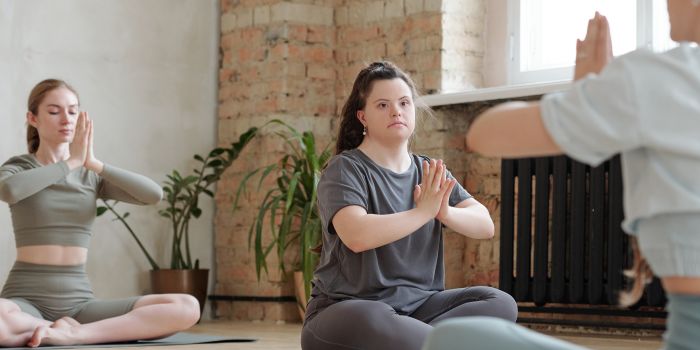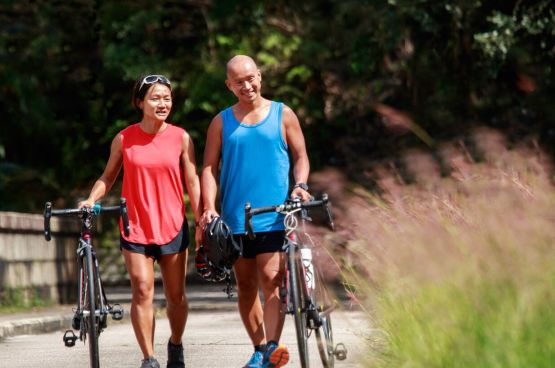Being active with a disability
Physical activity is an important part of everyday life. It helps keep us fit and healthy, both physically and mentally. But for some people with a disability, being active might seem challenging. It can be hard to know where to start with exercise, or know what options are available to you. Here, we’ll give some tips and ideas for being active with a disability.

What are the guidelines for physical activity?
Current guidelines recommend that all adults should be regularly physically active. This includes adults with a disability. Any amount of physical activity is better than none. The current government guidance for adults is:
- at least 150-300 minutes of moderate-intensity activity each week. This is activity that increases your breathing, but you’re still able to talk – for example, swimming, cycling and brisk walking
- or at least 75-150 minutes of vigorous-intensity physical activity each week. This is activity that makes you breathe fast, and it’s difficult to talk – for example, running and high intensity sports
- or a combination of moderate-intensity and vigorous-intensity activity
This might sound like a lot of physical activity to fit into a week, but it can help to think about it in smaller chunks. Doing a little each day, and changing the type of activity you do, can make it easier to reach those goals. In fact, it’s good to start with small amounts of activity and build it up over time. It’s easier to stick to new habits if you start small and work towards a bigger goal. For example, you could start with ten minutes of activity two to three times a week. As your body gets used to it, you can increase how long and how often you’re active.
You might find it helpful to talk to your GP, a physiotherapist, or an occupational therapist if you’re worried about what you can and can’t do. They’ll be able to suggest what exercise you could try, and what modifications you can make. They can also advise you about how to avoid getting an injury.
What are the benefits of physical activity?
Physical activity helps keep you fit, and it strengthens your muscles and bones, but it has lots of other benefits. It can:
- help you maintain a healthy weight and prevent cardiovascular disease
- improve your sleep
- boost your mood and self-esteem
- introduce you to new people, especially if you play a team sport
- make daily tasks easier
- improve your mobility and balance
- increase your independence
How can I stay active with a disability?
Physical activity doesn’t have to mean a new exercise regime. It could include household chores or hobbies, such as gardening, walking the dog, or even dancing in your kitchen! You can introduce physical activity into your day without making big changes. And you can fit it into your existing routine if you find it difficult to find time to exercise. For example, if you use public transport, you could get off a stop or two early and walk the rest of the way. Or if catching up with a friend, you could go for a walk together instead of sitting down with a coffee.
The most important thing is that you raise your heart rate and work your muscles within the range of your ability. Think about what you like to do, or a new activity you’d like to try. You’re more likely to keep active if you find an activity you enjoy. And if you can make it part of your weekly routine, even better! There are options out there for everyone, whatever your level of physical ability and fitness level.
What type of activities can I do with a disability?
Here are some activities you could try.
Walking
One of the easiest ways to introduce physical activity to your daily routine is by walking. Walking can improve your cardiovascular fitness, coordination, flexibility and balance, and you don’t need any special equipment to do it. If you feel like a change of scenery, Ramblers lists accessible walks throughout the UK.
Swimming
Swimming is a low-impact and safe way to exercise for people of all abilities. Why not see if your local pool or leisure centre has a class or club you could join? There are often a range of sessions for people of different abilities, so you can move at your own pace.
Online fitness classes
You don’t even have to leave home to keep fit. Online fitness classes can cover all sorts of exercise, from aerobics to Zumba. Whether you want to try cardiovascular exercise or strength training, there are videos online for everyone. For example, there are workouts tailored for wheelchair users and blind people.
Chair yoga
Chair yoga is a great way to fit exercise into your day, especially if you are a wheelchair user. It’s also a good exercise for improving your flexibility and balance.
Dancing
Dancing is a fun way to raise your heart rate and boost your mood. Why not take part in a dance class? ParaDance UK keeps a list of classes across the UK, and they’re open to everyone. You could even take along a friend or family member and dance together.
High-intensity interval training (HIIT)
High-intensity interval training (HIIT) workouts are short, high-intensity training sessions you can do at home. There are several apps and videos online that can coach you through them. And they can be tailored to different abilities too.
Join a gym
Going to the gym might not be for everyone. But if you’re interested in using one, gym staff can point out the equipment you can use safely. And if your gym is part of the Inclusive Fitness Initiative, that means it’s accessible for disabled people. Some gyms offer free trials, so you don’t have to join straight away.
What activities are suitable for wheelchair users?
If you use a wheelchair, there are several sports you could try, such as tennis, rugby, basketball, badminton, and wheelchair racing. Team sports - such as rugby and basketball - have an extra social element that can make them even more fun to take part in.
How can I find out more?
Programmes such as Get Out Get Active bring people of all backgrounds and abilities together to enjoy different activities.
Other projects, like Get Yourself Active and Active Partnerships, also provide resources and advice for anyone who’s interested in getting active. Or why not take a look on the Every body moves website to see what’s on near you?
Do you know how healthy you truly are? Bupa health assessments give you a clear overview of your health and a view of any future health risks. You'll receive a personal lifestyle action plan with health goals to reach for a happier, healthier you.
-
Sources Sources
- WHO guidelines on physical activity and sedentary behaviour. World Health Organization. www.who.int, published 25 November 2020
- Physical activity guidelines: disabled adults. UK Government. gov.uk, published 7 September 2019
- Exercising from home. Scope. www.scope.org.uk, last reviewed 16 March 2022
- Get active. Activity Alliance. www.activityalliance.org.uk, accessed 7 July 2022
- Inclusive fitness initiative. Activity Alliance. www.activityalliance.org.uk, accessed 7 July 2022
- Swimming. WheelPower. www.wheelpower.co.uk, accessed 7 July 2022
- Being active guide. Activity Alliance. www.activityalliance.org.uk, accessed 7 July 2022
- Adaptive yoga with Nina. WheelPower. www.wheelpower.org.uk, published 25 March 2020
- Find a sport or activity. WheelPower. www.wheelpower.org.uk, accessed 8 July 2022
- Participants. Get Out Get Active. www.getoutgetactive.co.uk, accessed 8 July 2022
- Everything disabled people need to know about getting active. Get Yourself Active. www.getyourselfactive.org, accessed 8 July 2022
- Upcoming sessions. Parasport. www.parasport.org.uk, accessed 11 July 2022
- Active at home. Get Yourself Active. www.getyourselfactive.org, accessed 11 July 2022
- How to join in. ParaDanceUK. www.paradance.org.uk, accessed 11 July 2022
- Simple cardio videos for disabled people. Get Yourself Active. www.getyourselfactive.org, accessed 12 July 2022
- Physical activity for adults and older adults. UK Government. gov.uk, published 7 September 2019
About our health information
At Bupa we produce a wealth of free health information for you and your family. This is because we believe that trustworthy information is essential in helping you make better decisions about your health and wellbeing.
Our information has been awarded the PIF TICK for trustworthy health information. It also follows the principles of the The Information Standard.

More exercise and fitness articles
Did you find our advice helpful?
We’d love to hear what you think. Our short survey takes just a few minutes to complete and helps us to keep improving our healthy lifestyle articles.
Legal disclaimer
This information was published by Bupa's Health Content Team and is based on reputable sources of medical evidence. It has been reviewed by appropriate medical or clinical professionals and deemed accurate on the date of review. Photos are only for illustrative purposes and do not reflect every presentation of a condition.
Any information about a treatment or procedure is generic, and does not necessarily describe that treatment or procedure as delivered by Bupa or its associated providers.
The information contained on this page and in any third party websites referred to on this page is not intended nor implied to be a substitute for professional medical advice nor is it intended to be for medical diagnosis or treatment. Third party websites are not owned or controlled by Bupa and any individual may be able to access and post messages on them. Bupa is not responsible for the content or availability of these third party websites. We do not accept advertising on this page.







